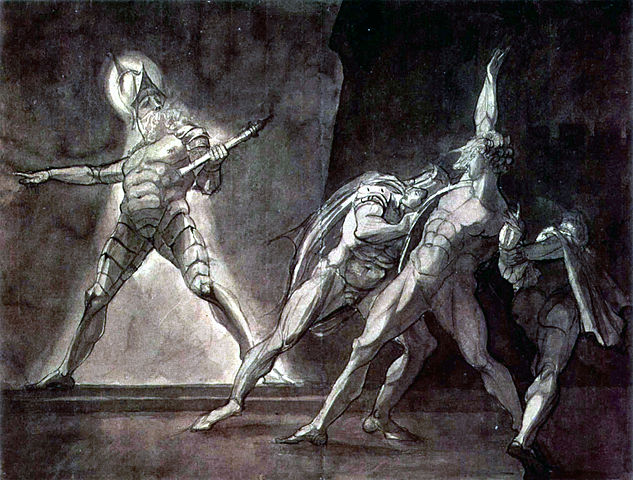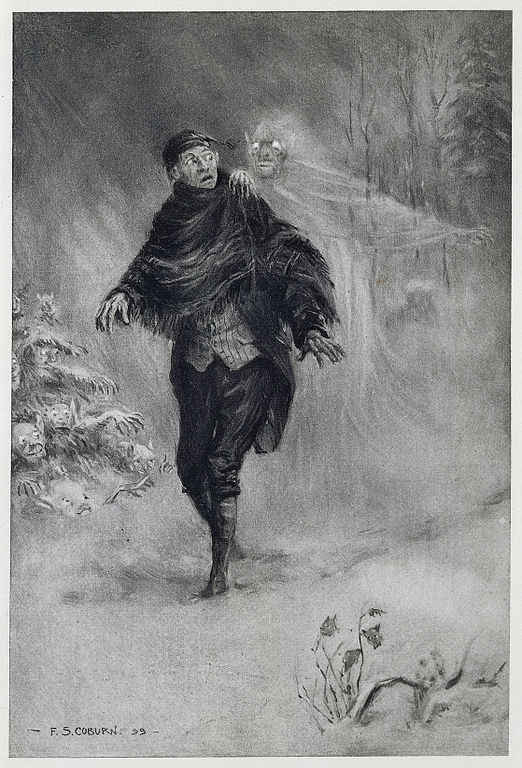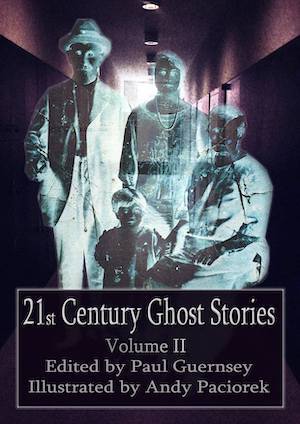by Editor
on December 2, 2014

Shakespeare’s Hamlet Encounters His Father’s Ghost. Illustration: Henry Fuseli (1741-1825).
Literary Ghosts: The Importance Of Hamlet’s Ghost
European playwrights and poets have incorporated ghosts into their work at least since the time of Homer. But until the time of Shakespeare, most literary ghosts had two things in common: 1) They were generally served up as “light fare” whose main function was to pleasantly frighten or otherwise entertain the audience rather than to deepen the audience’s understanding of the human mind and imagination, and 2) They were meant to be taken literally as ghosts; in other words, the audience was given no reason to think that the ghost was anything more or less than the actual shade of a departed person.
Then came Shakespeare, who along with his other astonishing innovations was one of the first Western writers to offer the possibility of a psychological ghost as opposed to a literal one. In Hamlet, most notably, Shakespeare leaves open the possibility that the armored ghost of Hamlet’s father may at least in part be the product of Hamlet’s own mind—specifically, a manifestation of his guilt at his failure to take action against his father’s murderer. [continue reading…]
by Editor
on November 30, 2014

Illustration For Washington Irving’s The Legend Of Sleepy Hollow. Artist: Frederick Simpson Coburn (1871-1960.)
What Does A Ghost Look Like?
Aalthough we don’t know for certain whether ghosts are real, we do know what they look like thanks to scientific surveys of 1,800 people who claim to have seen them. The surveys were conducted in 1968 and 1974 by Britain’s Institute of Psychophysical Research, and the results were reported in the 1975 book Apparitions, by Celia Green and Charles McCreery.
The researchers found that over 80 percent of ghosts were in the form of people, with the remainder taking the shape of animals and, occasionally, inanimate objects. The vast majority of animal ghosts were cats.
One surprising result of the surveys was that, rather than being transparent or translucent, most ghosts were described by people who had seen them as opaque—in other words, solid enough to block the view of whatever was behind them. The majority of apparitions also contained some color. However, a minority of ghosts are translucent or transparent, and it is also common for an opaque ghost to fade to transparency as it begins to disappear. [continue reading…]
by Editor
on November 30, 2014

Old Man And A Ghost. Drawing By Polish Artist Teodor Axentowicz (1859-1938).
What Color Is A Ghost?
No, ghosts are not always white, or black, or translucent—and they’re certainly not always invisible.
And how do we know, one way or the other? Because, regardless of whether ghosts are “real,” thousands of people have seen them, and some of those people have shared the details of their experiences with scientific researchers. Between 1968 and 1974, the Institute of Psychophysical Research in Britain interviewed 1,800 people who said they had seen one or more ghosts. The fascinating results were published in the 1975 book, Apparitions, by Celia Green and Charles McCreery. [continue reading…]
by Editor
on November 29, 2014
The Amityville Horror (1979)
One of the main interests in the original version of The Amityville Horror is that it is a fictionalization of supposedly actual paranormal events experienced in 1974 and 1975 by two separate families who lived in the same Long Island home.
At 112 Ocean Avenue in Amityville, New York, on November 13, 1974, 23-year-old Ronald DeFeo, Jr., shot to death his entire family while they slept—his parents, two brothers, and two sisters. He at first attempted an insanity defense, claiming that voices in the house had told him to commit the murders—but later he admitted drugs and alcohol were probably responsible. [continue reading…]




